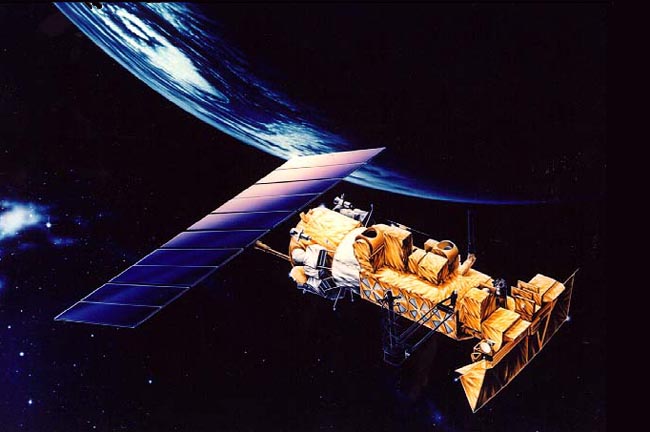Separating signal and noise in climate warming
Posted on 5 December 2011 by John Hartz
The following is a reprint of a news release posted by Lawrence Livermore National Laboratory on Nov 16, 2011.

A National Oceanic and Atmospheric Administration (NOAA) weather satellite. Image courtesy of NASA.
In order to separate human-caused global warming from the "noise" of purely natural climate fluctuations, temperature records must be at least 17 years long, according to climate scientists.
To address criticism of the reliability of thermometer records of surface warming, Lawrence Livermore National Laboratory scientists analyzed satellite measurements of the temperature of the lower troposphere (the region of the atmosphere from the surface to roughly five miles above) and saw a clear signal of human-induced warming of the planet.
Satellite measurements of atmospheric temperature are made with microwave radiometers, and are completely independent of surface thermometer measurements. The satellite data indicate that the lower troposphere has warmed by roughly 0.9 degrees Fahrenheit since the beginning of satellite temperature records in 1979. This increase is entirely consistent with the warming of Earth's surface estimated from thermometer records.
Recently, a number of global warming critics have focused attention on the behavior of Earth's temperature since 1998. They have argued that there has been little or no warming over the last 10 to 12 years, and that computer models of the climate system are not capable of simulating such short "hiatus periods" when models are run with human-caused changes in greenhouse gases.
"Looking at a single, noisy 10-year period is cherry picking, and does not provide reliable information about the presence or absence of human effects on climate," said Benjamin Santer, a climate scientist and lead author on an article in the Nov. 17 online edition of the Journal of Geophysical Research (Atmospheres).
Many scientific studies have identified a human "fingerprint" in observations of surface and lower tropospheric temperature changes. These detection and attribution studies look at long, multi-decade observational temperature records. Shorter periods generally have small signal to noise ratios, making it difficult to identify an anthropogenic signal with high statistical confidence, Santer said.
"In fingerprinting, we analyze longer, multi-decadal temperature records, and we beat down the large year-to-year temperature variability caused by purely natural phenomena (like El Ninos and La Ninas). This makes it easier to identify a slowly-emerging signal arising from gradual, human-caused changes in atmospheric levels of greenhouse gases," Santer said.
The LLNL-led research shows that climate models can and do simulate short, 10- to 12-year "hiatus periods" with minimal warming, even when the models are run with historical increases in greenhouse gases and sulfate aerosol particles. They find that tropospheric temperature records must be at least 17 years long to discriminate between internal climate noise and the signal of human-caused changes in the chemical composition of the atmosphere.
"One individual short-term trend doesn't tell you much about long-term climate change," Santer said. "A single decade of observational temperature data is inadequate for identifying a slowly evolving human-caused warming signal. In both the satellite observations and in computer models, short, 10-year tropospheric temperature trends are strongly influenced by the large noise of year-to-year climate variability."
The research team is made up of Santer and Livermore colleagues Charles Doutriaux, Peter Caldwell, Peter Gleckler, Detelina Ivanova, and Karl Taylor, and includes collaborators from Remote Sensing Systems, the National Center for Atmospheric Research, the University of Colorado, the Canadian Centre for Climate Modeling and Analysis, the National Oceanic and Atmospheric Administration, the U.K. Meteorology Office Hadley Centre, and Lawrence Berkeley National Laboratory.
Additional information:
Program for Climate Model Diagnosis and Intercomparison
"Climate models confirm more moisture in atmosphere attributed to humans," LLNL news release, Aug. 10, 2009
"Tropopause height becomes another climate-change 'fingerprint,' " Science & Technology Review, March 2004
"Livermore Researchers Discover Uncertainties in Climate Satellite Data Hamper Detection of Global Warming," LLNL news release, May 1, 2003































 Arguments
Arguments






























- There is a belief that by the application of ‘smoothing functions’, these variations in systematic boundary conditions may be ignored
- the crude Laplacian ‘steady state’ model favoured by climate modellers
- It is now accepted that linear approximation reduces the potential behaviours in a physical system
- We seem prepared to hang all on a few decades of data, and a very limited understanding of the dynamic behaviours involved
- There is an almost deadly silence on the mathematical background to climate modelling
- smoothing functions were in common use, with seemingly little understanding of their effect on dynamics
When you have learned enough about how climate models work to understand that all of these assertions are false, and that the rest of your statements about mathematics, dynamics, Laplace, Lagrange and linear systems simply do not apply to the topic of modern climate models, then a meaningful discussion can proceed from that point. If you seriously consider yourself qualified to understand, then the best place to start is here, the GISS GCM ModelE. You can view the documentation, download the source code, and compile and run it yourself. There are myriad other sources of information on the web, including, as you have already been told, books on climate modeling, web pages on climate modeling, source code, models you can run online, models you can download, and more. There is no excuse to speak without understanding. Climate models are not linear systems. Read. Learn. Then we'll talk.[DB] "The Atlantic Conveyor has been weakening since the 1980s. Such a change tips the system into a new state space very quickly, with very unpleasant effects for Northern Europe."
Based on what? Source citation needed.
Inflammatory snipped.
[DB] "Comments on models (but only if supported by references) should be made on this thread: How reliable are climate models?"
Make it so.